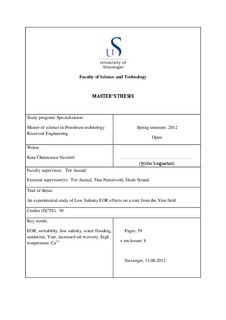| dc.contributor.author | Navratil, Kine Christensen | |
| dc.date.accessioned | 2012-11-12T13:37:37Z | |
| dc.date.available | 2012-11-12T13:37:37Z | |
| dc.date.issued | 2012 | |
| dc.identifier.uri | http://hdl.handle.net/11250/183460 | |
| dc.description | Master's thesis in Petroleum engineering | no_NO |
| dc.description.abstract | The best known proposed mechanisms for low salinity effect are fines migration, pH increase, double layer expansion and multicomponent ionic exchange (MIE). Even though many mechanisms have been proposed, none of them have been accepted as the main mechanism behind the low salinity effect. The complex oil/brine/rock interactions are still being debated in the literature. The type of clays present in the sandstone and polar components in the crude oil, are important factors for observing low salinity effect. The temperature and the amount of divalent cations in the formation water, especially Ca2+ and Mg2+, are also important factors for observing low salinity effect. It is assumed that the low salinity effect is a result of altering the wettability of the rock to a more water-wet condition. The rock becomes more water-wet when organic material is desorbed from the clay surface. Low initial pH is important in order for adsorption of polar components to the permanent negatively charged clay surface to occur. Desorption of Ca2+ ions from the clay surface and desorption of organic material from the clay surface will occur as a result of acid/base reactions. This will promote a pH increase.
In this work the potential of low salinity effect after flooding with seawater and diluted seawater in a Yme core has been evaluated. The oil recovery by formation water was about 65% of the original oil in place (OOIP). No additional oil recovery was observed after flooding with sea water and 50 times diluted sea water. High temperature and a large concentration of Ca2+ in the initial formation water, may be the main reasons for why no low salinity effect was observed. | no_NO |
| dc.language.iso | eng | no_NO |
| dc.publisher | University of Stavanger, Norway | no_NO |
| dc.relation.ispartofseries | Masteroppgave/UIS-TN-IPT/2012; | |
| dc.subject | petroleumsteknologi | no_NO |
| dc.subject | reservoarteknologi | no_NO |
| dc.subject | EOR | no_NO |
| dc.subject | wettability | no_NO |
| dc.subject | low salinity | no_NO |
| dc.subject | water flooding | no_NO |
| dc.subject | increased oil recovery | no_NO |
| dc.subject | Yme | no_NO |
| dc.title | An experimental study of low salinity EOR effects on a core from the Yme field | no_NO |
| dc.type | Master thesis | no_NO |
| dc.subject.nsi | VDP::Technology: 500::Rock and petroleum disciplines: 510::Petroleum engineering: 512 | no_NO |
